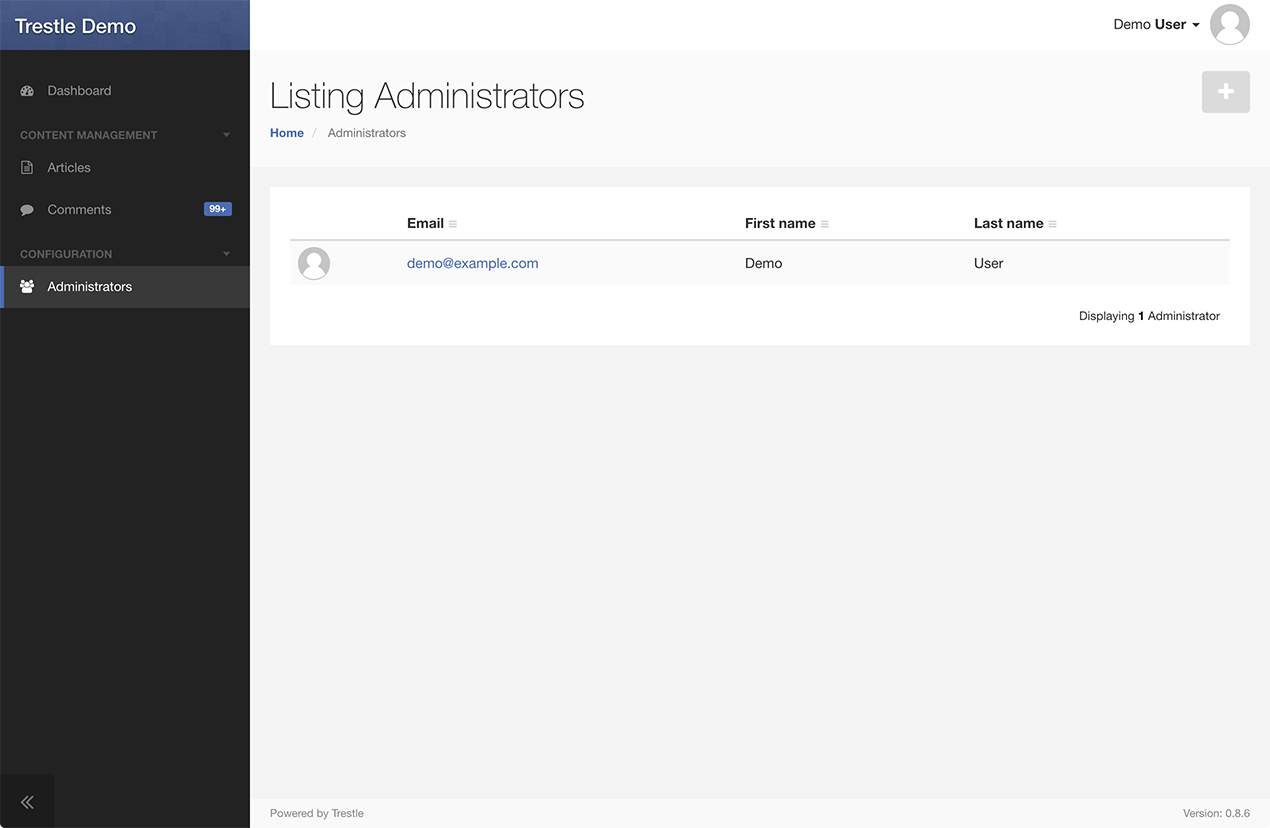# Trestle Authentication (trestle-auth)
[](https://rubygems.org/gems/trestle-auth)
[](https://travis-ci.org/TrestleAdmin/trestle-auth)
[](https://coveralls.io/github/TrestleAdmin/trestle-auth)
> Authentication plugin for the Trestle admin framework

 ## Getting Started
These instructions assume you have a working Trestle application. See the [Getting Started](https://github.com/TrestleAdmin/trestle#getting-started) section in the Trestle README.
To integrate trestle-auth, first add it to your application's Gemfile, and then run `bundle install`:
```ruby
gem 'trestle-auth'
```
As of version 0.4.0, trestle-auth now supports multiple authentication backends including Devise/Warden.
### Option 1: Built-in Integration
Run the install generator to add the configuration to `config/initializers/trestle.rb`, and generate a `User` model and admin resource.
$ rails generate trestle:auth:install User
(if no user model name is specified it will default to `Administrator`)
Then run your migrations with `rake db:migrate` and create an initial admin user from within `rails console`:
```ruby
User.create(email: "admin@example.com", password: "password", first_name: "Admin", last_name: "User")
```
After restarting your Rails server, any attempt to access a page within your admin will redirect you to the login page.
### Option 2: Devise Integration
If you already have an existing user model and Devise integration, you can configure trestle-auth to use that instead.
$ rails generate trestle:auth:install User --devise
Replace `User` with the name of your Devise user model. If not specified, it will default to `Administrator`.
## Configuration
After running the `trestle:auth:install` generator, check your `config/initializers/trestle.rb` for further configuration options.
## License
The gem is available as open source under the terms of the [LGPLv3 License](https://opensource.org/licenses/LGPL-3.0).
## Getting Started
These instructions assume you have a working Trestle application. See the [Getting Started](https://github.com/TrestleAdmin/trestle#getting-started) section in the Trestle README.
To integrate trestle-auth, first add it to your application's Gemfile, and then run `bundle install`:
```ruby
gem 'trestle-auth'
```
As of version 0.4.0, trestle-auth now supports multiple authentication backends including Devise/Warden.
### Option 1: Built-in Integration
Run the install generator to add the configuration to `config/initializers/trestle.rb`, and generate a `User` model and admin resource.
$ rails generate trestle:auth:install User
(if no user model name is specified it will default to `Administrator`)
Then run your migrations with `rake db:migrate` and create an initial admin user from within `rails console`:
```ruby
User.create(email: "admin@example.com", password: "password", first_name: "Admin", last_name: "User")
```
After restarting your Rails server, any attempt to access a page within your admin will redirect you to the login page.
### Option 2: Devise Integration
If you already have an existing user model and Devise integration, you can configure trestle-auth to use that instead.
$ rails generate trestle:auth:install User --devise
Replace `User` with the name of your Devise user model. If not specified, it will default to `Administrator`.
## Configuration
After running the `trestle:auth:install` generator, check your `config/initializers/trestle.rb` for further configuration options.
## License
The gem is available as open source under the terms of the [LGPLv3 License](https://opensource.org/licenses/LGPL-3.0).

 ## Getting Started
These instructions assume you have a working Trestle application. See the [Getting Started](https://github.com/TrestleAdmin/trestle#getting-started) section in the Trestle README.
To integrate trestle-auth, first add it to your application's Gemfile, and then run `bundle install`:
```ruby
gem 'trestle-auth'
```
As of version 0.4.0, trestle-auth now supports multiple authentication backends including Devise/Warden.
### Option 1: Built-in Integration
Run the install generator to add the configuration to `config/initializers/trestle.rb`, and generate a `User` model and admin resource.
$ rails generate trestle:auth:install User
(if no user model name is specified it will default to `Administrator`)
Then run your migrations with `rake db:migrate` and create an initial admin user from within `rails console`:
```ruby
User.create(email: "admin@example.com", password: "password", first_name: "Admin", last_name: "User")
```
After restarting your Rails server, any attempt to access a page within your admin will redirect you to the login page.
### Option 2: Devise Integration
If you already have an existing user model and Devise integration, you can configure trestle-auth to use that instead.
$ rails generate trestle:auth:install User --devise
Replace `User` with the name of your Devise user model. If not specified, it will default to `Administrator`.
## Configuration
After running the `trestle:auth:install` generator, check your `config/initializers/trestle.rb` for further configuration options.
## License
The gem is available as open source under the terms of the [LGPLv3 License](https://opensource.org/licenses/LGPL-3.0).
## Getting Started
These instructions assume you have a working Trestle application. See the [Getting Started](https://github.com/TrestleAdmin/trestle#getting-started) section in the Trestle README.
To integrate trestle-auth, first add it to your application's Gemfile, and then run `bundle install`:
```ruby
gem 'trestle-auth'
```
As of version 0.4.0, trestle-auth now supports multiple authentication backends including Devise/Warden.
### Option 1: Built-in Integration
Run the install generator to add the configuration to `config/initializers/trestle.rb`, and generate a `User` model and admin resource.
$ rails generate trestle:auth:install User
(if no user model name is specified it will default to `Administrator`)
Then run your migrations with `rake db:migrate` and create an initial admin user from within `rails console`:
```ruby
User.create(email: "admin@example.com", password: "password", first_name: "Admin", last_name: "User")
```
After restarting your Rails server, any attempt to access a page within your admin will redirect you to the login page.
### Option 2: Devise Integration
If you already have an existing user model and Devise integration, you can configure trestle-auth to use that instead.
$ rails generate trestle:auth:install User --devise
Replace `User` with the name of your Devise user model. If not specified, it will default to `Administrator`.
## Configuration
After running the `trestle:auth:install` generator, check your `config/initializers/trestle.rb` for further configuration options.
## License
The gem is available as open source under the terms of the [LGPLv3 License](https://opensource.org/licenses/LGPL-3.0).